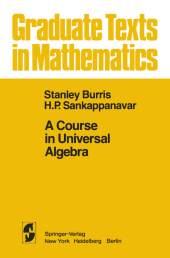 Neuerscheinungen 2011Stand: 2020-01-07 |
Schnellsuche
ISBN/Stichwort/Autor
|
Herderstraße 10
10625 Berlin
Tel.: 030 315 714 16
Fax 030 315 714 14
info@buchspektrum.de |

S. Burris, H. P. Sankappanavar
(Beteiligte)
A Course in Universal Algebra
1981. 2011. xvi, 276 S. 235 mm
Verlag/Jahr: SPRINGER, BERLIN; SPRINGER NEW YORK; SPRINGER 2011
ISBN: 1-461-38132-0 (1461381320)
Neue ISBN: 978-1-461-38132-7 (9781461381327)
Preis und Lieferzeit: Bitte klicken
Universal algebra has enjoyed a particularly explosive growth in the last twenty years, and a student entering the subject now will find a bewildering amount of material to digest. This text is not intended to be encyclopedic; rather, a few themes central to universal algebra have been developed sufficiently to bring the reader to the brink of current research. The choice of topics most certainly reflects the authors´ interests. Chapter I contains a brief but substantial introduction to lattices, and to the close connection between complete lattices and closure operators. In particular, everything necessary for the subsequent study of congruence lattices is included. Chapter II develops the most general and fundamental notions of uni versal algebra-these include the results that apply to all types of algebras, such as the homomorphism and isomorphism theorems. Free algebras are discussed in great detail-we use them to derive the existence of simple algebras, the rules of equational logic, and the important Mal´cev conditions. We introduce the notion of classifying a variety by properties of (the lattices of) congruences on members of the variety. Also, the center of an algebra is defined and used to characterize modules (up to polynomial equivalence). In Chapter III we show how neatly two famous results-the refutation of Euler´s conjecture on orthogonal Latin squares and Kleene´s character ization of languages accepted by finite automata-can be presented using universal algebra. We predict that such "applied universal algebra" will become much more prominent.
Preliminaries.- I Lattices.-
1. Definitions of Lattices.-
2. Isomorphic Lattices, and Sublattices.-
3. Distributive and Modular Lattices.-
4. Complete Lattices, Equivalence Relations, and Algebraic Lattices.-
5. Closure Operators.- II The Elements of Universal Algebra.-
1. Definition and Examples of Algebras.-
2. Isomorphic Algebras, and Subalgebras.-
3. Algebraic Lattices and Subuniverses.-
4. The Irredundant Basis Theorem.-
5. Congruences and Quotient Algebras.-
6. Homomorphisms and the Homomorphism and Isomorphism Theorems.-
7. Direct Products, Factor Congruences, and Directly Indecomposable Algebras.-
8. Subdirect Products, Subdirectly Irreducible Algebras, and Simple Algebras.-
9. Class Operators and Varieties.-
10. Terms, Term Algebras, and Free Algebras.-
11. Identities, Free Algebras, and Birkhoff´s Theorem.-
12. Mal´cev Conditions.-
13. The Center of an Algebra.-
14. Equational Logic and Fully Invariant Congruences.- III Selected Topics.-
1. Steiner Triple Systems, Squags, and Sloops.-
2. Quasigroups, Loops, and Latin Squares.-
3. Orthogonal Latin Squares.-
4. Finite State Acceptors.- IV Starting from Boolean Algebras.-
1. Boolean Algebras.-
2. Boolean Rings.-
3. Filters and Ideals.-
4. Stone Duality.-
5. Boolean Powers.-
6. Ultraproducts and Congruence-distributive Varieties.-
7. Primal Algebras.-
8. Boolean Products.-
9. Discriminator Varieties.-
10. Quasiprimal Algebras.-
11. Functionally Complete Algebras and Skew-free Algebras.-
12. Semisimple Varieties.-
13. Directly Representable Varieties.- V Connections with Model Theory.-
1. First-order Languages, First-order Structures, and Satisfaction.-
2. Reduced Products and Ultraproducts.-
3. Principal Congruence Formulas.-
4. Three Finite Basis Theorems.-
5. Semantic Embeddings and Undecidability.- Recent Developments and Open Problems.- Author Index.


